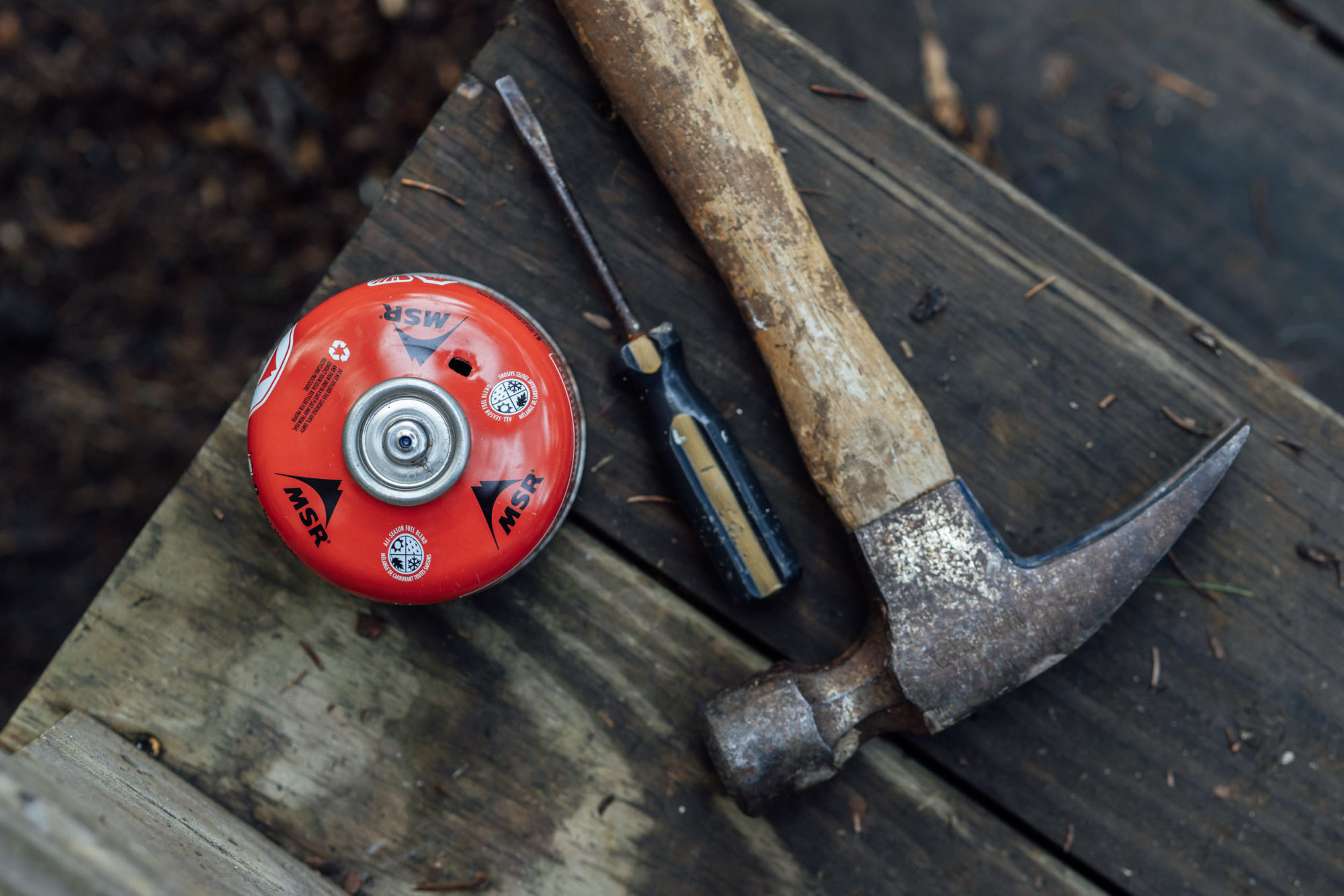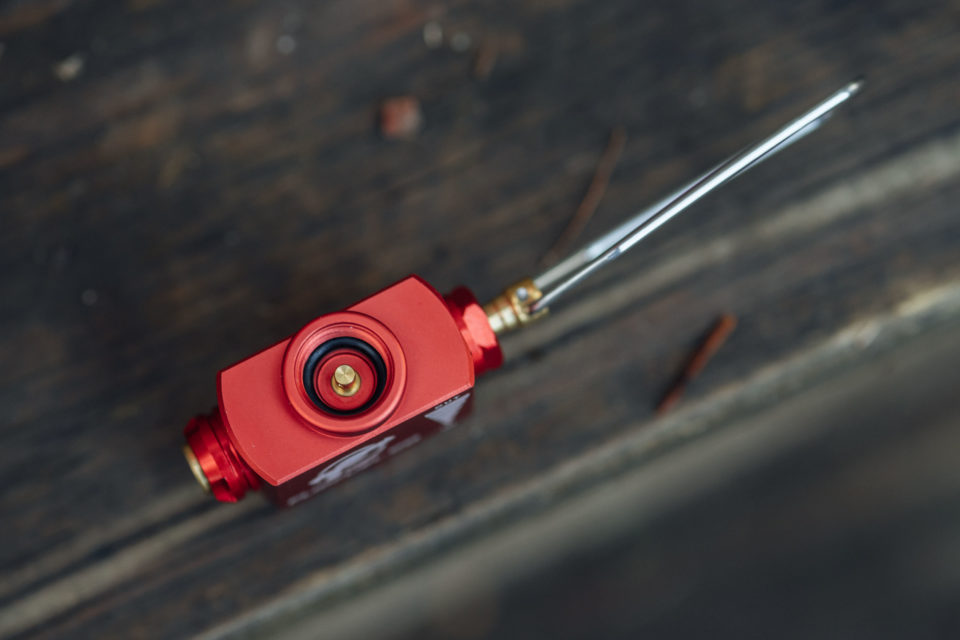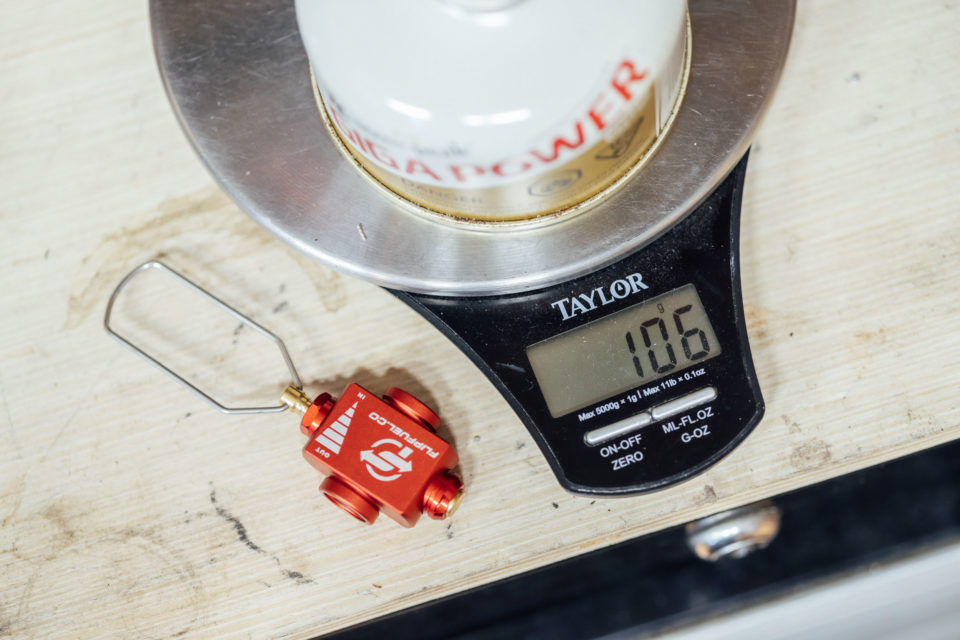FlipFuel Review: Canister Fuel Transfer Device
Share This
The FlipFuel fuel transfer device allows you to transfer gas from one canister to the next, which means you can consolidate those partly filled fuel canisters and avoid having to pedal into the backcountry with a half-full one. We had the chance to put one to the test for this review…
If you use canister stoves and have found yourself with a collection of half-full fuel canisters in your camping gear bin, you’re not alone. I have a half dozen of them with questionable amounts of fuel in them. I also sometimes find myself bringing two of them on overnight campouts, just to ensure I don’t have to go without my morning coffee. Fortunately, there is a solution. FlipFuel is a relatively simple fuel transfer valve that uses the difference in temperature between two canisters to allow fuel to flow from one to the other. It’s compatible with most isobutane canisters, such as those from Jetboil, MSR, Snow Peak, and others.
In this video, Neil tests the FlipFuel on a variety of canisters in several sizes. He also talks through canister fuels, what’s in them, the different sizes, and how the FlipFuel can play a key role in saving money and space by transferring fuel from one canister to the next.
In use, I had a similar experience as Neil. It’s pretty easy to use. You simply put the intake canister on ice and the output canister near a heat source (with the obvious precautions not to get it too hot or near an open flame). Then, screw them into the FlipFuel device in the appropriate configuration and open the valve. As outlined in the video review, it’s essential to pay close attention to weights. I also found that it was important to make sure the intake canister is quite cold and the output canister is pretty warm.
As inexpensive as it is, I think the FlipFuel is worth it if you use canister stoves regularly. It easily allows you to transfer fuel from one isobutane canister to another, potentially minimizing waste and preventing the need to carry multiple half-full canisters out into the backcountry.
My one con is that it seems impossible to get all the fuel out of the output canister. Sometimes, you can get a little more if you perform multiple fuel transfer sessions, cooling down the intake canister and warming up the output canister in between. But, I still found there was a little left. Tested with a Pocket Rocket, there was about 80-90 seconds worth of fuel when run wide open.
Recycling Isobutane Canisters
Using canister stoves might not be as sustainable as something like an alcohol stove, as there’s arguably less waste from the latter. However, using the FlipFuel device as Neil did in the review—by transferring fuel from a large 16 oz (450g) canister into a small 3.9 oz (110g) one (for use while bikepacking)—could result in much less waste. And, theoretically, you can recycle isobutane canisters.
Isobutane canisters are made of painted steel and small plastic and rubber parts for the valve. They can be recycled, although it’s not as easy as it sounds, and you can’t just toss your spent canister into the recycling bin. Fuel canisters can only be recycled if “mixed metal” is accepted, and even then, only when they’re properly drained and punctured. Here’s how to recycle your fuel canisters:
Step 1: Empty the Canister
Make sure the canister is completely empty. It’s best to use all the gas while cooking to burn off the hydrocarbons instead of releasing them. However, if you think there might be a little gas left in the can, you can purge it by attaching your stove, inverting it, and opening the valve.

Step 2: Puncture the Canister
In order to be recycled, spent fuel canisters have to be punctured. There are a few ways to go about this. One is to use this tool made by JetBoil, but you certainly don’t need it. The other two options are to use a simple old-school can opener or a hammer and screwdriver, which is the best method we’ve found. It’s not recommended to use a saw or any kind of power tool as it could cause a spark. Also, you don’t need to remove the valve to meet the requirements for mixed metal recycling.
Step 3: Find a Recycler
This last step is where things get tricky and a little fuzzy. Few curbside recycling programs handle mixed metals, and virtually none recycle fuel canisters. Most people recommend dropping them off at a metal recycling center. If you go this route, contact your local recycling center for advice. We did just that and spoke with the manager of our county solid waste center, which provides mixed metal recycling. They told us that even if a canister is punctured, it might not get recycled because they don’t always see the hole and can’t quickly identify that it’s empty. They recommended that after you empty it and puncture it, it’s best to either cut it in half or crush it to make it not look like a fuel canister. That being said, cutting it in half could still potentially have some risk.
Another option is to find a third party that handles fuel canister recycling. We read that REI had a program to recycle them, but I contacted REI via their website and called our local store to find out that they do not accept them. Some municipalities do accept them—probably in California, maybe some in Colorado. As a last alternative, once the canisters are emptied and punctured, some metal scrap yards may take them.
It’s worth pointing out that the team at FlipFuel didn’t invent anything new with their Fuel Transfer Device. You can find a handful of nearly identical units on Amazon (like this one), AliExpress, and elsewhere, though we’d not happened upon any of them until recently. What FlipFuel offers for a premium is a custom-anodized version of the device and a US-based company to interact with for warranty issues and other customer service requests.
- Model Tested: FlipFuel Fuel Transfer Device
- Actual Weight: 35 grams
- Place of Manufacture: China
- Price: $35
- Manufacturer’s Details: FlipFuel.co
Pros
- Relatively inexpensive solution
- Prevents the need to carry multiple half-empty containers
- Can potentially reduce waste if used properly
Cons
- Doesn’t completely empty the fuel canister
- Slightly more pricey than similar products available
Please keep the conversation civil, constructive, and inclusive, or your comment will be removed.
































